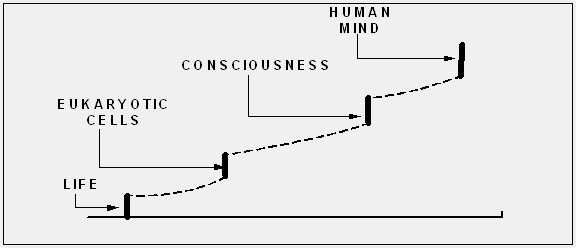Chapter 6
Probably Improbable but We Believe
Humanism vs. Christianity
The Polarization of America
by Patrick Vosse

Living Water at Christianity Oasis
John 7:38 He that believeth on me, as the scripture hath said,
out of his belly shall flow rivers of living water.

Part One
Evolution vs. Creationism
Chapter 6 - Probably Improbable but We Believe
In the previous chapter, we discussed the history of the evolution hypothesis and touched upon some of the difficulties with it. In this chapter, we will discuss in more detail why evolution is nothing more than speculation and may not even be a hypothesis. We will attempt to show that, for evolution to occur by only natural means, more faith is required than to accept divine intervention.
Anthrotopy and the "Mount Improbable" Hypocrisy
Consider how improbable it is that we are here. The earth has to have a specific size, distance form the sun, shape of orbit, composition of elements, a sun of a specific type and size, and numerous other factors that have to be "just so" otherwise life could not exist. Take it a step further: The factors that control the existence and composition of the universe are even more complex. Small variations in several of the physical constants that determine how matter exists could result in a universe without stars or without all the elements necessary for life to exist. In fact, the size of the universe, as immense as it is (billions of light years across), has to be just this size in order for life to exist.
We do not know the probability of each of the factors required for our universe to exist as it does, in fact, we might not know all the factors required; scientists are still working on that. But what is known is that the odds against the existence of our universe with the physical attributes necessary for life are very high. Pardon the pun: astronomically high. The odds against our planet to exist as it does are billions or even trillions to 1 (actually, we will show the odds are much greater than that). But no one really knows just how improbable our life is.
Consider just one characteristic of matter, gravity. If the gravitational force was slightly stronger, shortly after the "Big Bang" everything would collapse back on itself and the birth of the universe would be aborted. If the gravitational force was slightly less, matter would disperse in an ever-expanding cloud and the stars, planets and galaxies would never form. And that is just one example. The same is true for all the characteristics of the universe. Every characteristic has to be just as it is or the universe as we know it would not exist.
In their book, The Anthropic Cosmological Principle, John D. Borrow and Frank J. Tipler discuss the improbability of the existence of our universe and propose possibilities for how our improbable universe came to be. It is an "interesting" proposal. We know that, no mater how improbable, our universe came into existence in a way that it can support life – because we are here. If the probability is say 1 billion to 1, and there was just one universe, atheistic science and atheistic evolution would be in trouble. But the Anthropic Principle has a "solution": Multiple universes. What if, they say, there were 1 billion universes? In that case, the probability becomes 100 percent. For them, it does not matter how improbable a naturally caused universe is. Our existence proves that it is possible. Of course, that thinking applies to a theistically caused universe equally well, but that is simply dismissed. But look at the logic used here. If the odds are 1 billion to 1 against our universe being as it is, if there are 1 billion universes the odds become 100 percent in favor of our universe being as it is. Therefore, there are 1 billion universes. There is no proof of any statement in this circular logic–it is an embarrassment to science. It shows however, the lengths to which Evolutionist will go to "prove" their point.
The problem is that this multi-universe idea is just that, only an idea. No evidence, no observations. No reason at all to consider it except for the fact that, without it, God becomes the more probable answer. However, the improbability of our existence does not end with the high odds against the "just so" universe, there are several steps in the evolution hypothesis that are just as problematic and conveniently overlooked or dismissed by the evolutionist.
The Solar System
We often overlook the fact that if our solar system was not exactly as it is, we would not be here. Let us start with the sun. If it was too hot and there was more radiation, no life could exist. The sun has to be the right size to maintain a stable source of energy of the correct type and for sufficient time to allow all the development of life on earth. How many stars are like our sun? Not many. Approximately two-thirds of all stars are binary, that is, two or more stars that orbit each other; and, while planets can exist in a binary system, the erratic orbits and gravitational forces make earth-like planets unlikely. Of the remaining 33 percent of single-star systems, 76 percent are class M red dwarfs. These are in their last days (for a star, that is–they still have a few million years left). Their radiation spectrum is quite different from that of the sun and they are cooler. Then there are the class K stars that are much cooler than the sun and would give us a very frigid climate indeed. The class K stars make up about 12 percent of the single-star systems. The class F stars are hotter than the sun and make up about 3 percent of the single-star systems. The remaining classes of stars are much hotter than the sun and comprise about 1 percent of the single star systems. That means the sun-like stars make up less than 2 percent of all stars. You will hear scientific speculators say that, since there are trillions of stars, the probability of an earth-like stare is very high–but it is only 2 percent.
The planets play a role as well. Most astronomers agree that the big gas giants, Jupiter, Saturn, Neptune, and Uranus protect earth from meteors, comets and other space debris. Their enormous gravity acts like a giant vacuum cleaner that picks up objects that would otherwise strike earth and not allow life to exist. It is interesting to note that astronomers have located more than 100 stars with planets. Small planets are difficult to determine with current technology so all the planets so far discovered have been gas giants like Jupiter and Saturn. Most of these are located near their star, not far as in our solar system. Also, our solar system has to have numerous objects besides the planets such as meteors and comets, for life to exist on earth. This is discussed in detail in the sections below.
What is the probability that we live in a solar system with a star that is just right for life, with planets arranged in such a way as to protect the "third rock from the sun"? Amazingly, since there are so many stars in the universe, even though the probability is low, it is likely that if one searched long enough a solar system like ours with a planet like ours might be found.
The Earth
The earth is uniquely suited for life. The size is just right to hold the atmosphere. Its orbit is not too elliptical and that prevents extremes in temperature. It has an iron core with a differential rotation that causes a strong magnetic field without which solar radiation would kill all life. There is water in abundance and an atmosphere that has the right amount of oxygen (either too much or too little would kill us) and just the right amount of pressure. Many scientists believe that much of the earth's water came from collisions with comets in the early stages of formation. (The composition of comets is mostly water.) In order for this to happen, earth needs to be in a solar system with a sufficient number of comets to assure collisions for the acquisition of adequate water but not so many as to destroy life; again, just the right amount. The chemical composition of the earth provides everything necessary to sustain life. It is possible that somewhere in the universe, there is another planet that has all these factors in the same proportion. But it is not likely that there are many within a solar system like ours.
The Moon
Ah, the moon. What could be more romantic than a full moon in, as the songwriter says, June. But the moon is more than a pretty face. Adherents of the Rare Earth Theory postulate that a large moon such as ours is not merely a benefit for life, but essential for life. Evolutionary scientists credit the moon's tidal influence as a contributor to the development of life on our world. The sun alone would cause some tides to occur, though they would be far less than those the moon creates. The higher tides afforded us by Luna, the moon's scientific name, have made long swaths of coastline into areas of that regularly shift between dry and wet. These variable areas, according to evolutionary scientist, provided the environment for early sea life to make the transition from life in the ocean to life on land. Areas farther from shore are only dry at the peak of low tide, and the period of exposure to air increases as one nears shore, allowing for a subtle progression toward a waterless environment. Early transitional life, the evolutionist claims, needed the advantage of this gradual change to adapt to the wildly different demands of surviving outside the ocean. The tidal forces also cause a morphing action on the earth that helps to maintain Earth's critical temperature. Without the moon, the earth would rotate faster than it does resulting in a more turbulent atmosphere that is not conducive to life.
Luna is unique among the observed celestial bodies. There is no other satellite closer in size and composition to its mother-planet, and the Earth/moon system is the only tidally locked pair. All of the other worlds either lack satellites or have captured them from other places. Astronomers believe that the moon was formed by a collision between Earth and a Mars-sized body that struck the earth at on oblique angle during the early stages of formation. The moon is a remnant of that collision that did not have sufficient velocity to escape the earth's gravity. Unique in its size; unique in its distance from it mother-planet; unique in its formation–go figure.
Life and its Development
Life is an amazing thing, but what is more amazing is how it started– spontaneously from a mixture of chemicals. This gives Evolutionists a severe headache. Somehow, life spontaneously emerged from the "prebiotic" mixture of organic molecules. Somehow, something emerged that could grow and reproduce itself. Somehow. No one knows how. For decades, scientists have tried to duplicate the conditions existing on the earth just prior to the emergence of life and cause life to spontaneously pop into existence in the laboratory. And for decades they have failed. Consider what is required. First amino acids must form, and fortunately, they are plentiful. Next, the right kind of amino acids (there are many different kinds) must connect to form a chain–and not just connect, but hundreds or thousands of molecules must connect in the right sequence. Just how that would happen is still a mystery because, remember, there is no life yet, just chemicals. Moreover, there are hundreds of proteins necessary for life so this remarkable linking process has to happen for each protein. As amazing as that is, the real miracle is yet to come. This has scientists up late at night; somehow, these chemicals must find a way to copy themselves, a phenomenon never observed, and split into two molecules, each of which can repeat the process– combine, grow, copy, split. This is analogous to the leftover chicken soup you put in the refrigerator coming to life.
If, as the Evolutionists claim, evolution proceeds through natural means without a divine influence, then the spontaneous synthesis of life must be the first experiment to prove that hypothesis. So, if your leftover chicken soup suddenly begins to grow and make baby chicken soups, please contact your nearest scientist immediately! Speaking of chickens, it has been asked, "Which came first, the chicken or the egg?" We ask a similar question here, "Which came first, the molecule that causes life, or the life that causes the molecule?"
In his book, Climbing Mount Improbable, Richard Dawkins addresses the question of gradual discrete changes in the evolutionary process that enable the eventual accumulation of large changes. Evolutionists accept that evolution cannot account for major dramatic changes, say from an ape to a man, in one giant step but it is necessary for a series of very small gradual changes to occur. While the one giant step is impossible, each of the "baby" steps is possible, they claim, and can be assigned a discrete probability, even if small. At least so the theory goes.
This is shown graphically in Figure 2, below. The mountain on the left side of the figure is very steep, representing the impossible ascent of organisms in an evolutionary giant step (or a few giant steps), i.e., the Improbable Mountain. The right side of the figure represents the gentler slope, starting at the foothills and gradually, in small increments, ascending over considerable time to the peak. The proposition is that, while a major, significant change is impossible, a very small change in an organism is highly probable and, in fact, such changes have been observed. Over time, a sufficient number of changes will accumulate with the resulting new species. It is, therefore, not necessary to consider the improbable change in one or a few giant steps, but we can accept, with the higher probability of each small step, the evolution from one species to another. Now, that sounds quite reasonable.
Figure 2. Richard Dawkins' "Improbable Mountain". Evolutionists concede that organisms cannot make the "giant step" change from one species to another as shown on the left. Evolution, they claim, occurs in small increments over millions of years, similar to the gentle slope on the right.
However, there is a problem with the evolution hypothesis that is not well known to the nonprofessional. I am not saying this is being kept a secret, but Evolutionists, when trying to defend their hypothesis do not seem to have the objectivity observed in other areas of science. In his book The God Delusion, Dawkins acknowledges a significant difficulty with the evolution hypothesis. There are at least 4 steps in the evolutionary process that are not the higher probability "baby" steps that evolution requires. These are origin of life, development of eukaryotic cells,[1] emergence of conscience, and the human mind. Each of these steps is, in fact, not well understood by scientists. However, like the improbability of the existence of our unique universe, each step has a very low probability of naturally occurring. As Gould et. al. put it: "The main problem with such phyletic gradualism is that the fossil record provides so little evidence for it. Very rarely can we trace the gradual transformation of one entire species into another through a finely graded sequence of intermediary forms."[2]
The odds against each step are unknown, but certainly on the order of a billion or a trillion to one. As Dawkins says odds so low that each step is a "one off" event. So, evolution, unlike the smooth gradual ascent shown in Figure 2, is actually like Figure 3, below.
Cells that are organized into complex structures enclosed within membranes. The defining membrane-bound structure that differentiates eukaryotic cells from prokaryotic cells is the nucleus. Many eukaryotic cells contain other membrane-bound organelles such as mitochondria, chloroplasts and Golgi bodies. Cell division in eukaryotes is different from organisms without a nucleus (prokaryotes). It involves separating the duplicated chromosomes, through movements directed by microtubules. Eukaryotic reproduction is sexual and result in offspring different from the parents. Prokaryotic cells reproduce by dividing to produce two identical cells.
Figure 3. There are at least 4 "Giant Steps" in the development of organisms that Evolutionists admit cannot be explained by evolutionary process: Life, Eukaryotic Cells, Consciousness, and the Human Mind.
Now, we find that the evolution hypothesis has some serious unanswered questions. The cosmologists say that the odds against our unique universe that could give rise to life billions or trillions to one. The odds against life spontaneously arising are also, billions or trillions to one, as are the odds of the development eukaryotic cells, consciousness, and the human mind.
When dealing with related events having specified probabilities, mathematicians use Boolean algebra.[3] When a result is dependant on events in such a way that if any of the events occurs, the result will occur, then the probabilities of the events are ADDED and this has the effect of INCREASING the chance of the result occurring.
When, as in the case of evolution, all the events must occur before the result is realized, the probabilities of the events are MULTIPLIED and this has the effect of DECREASING the chance of the result occurring. In The God Delusion, Dawkins used an example probability of 1 billion to one for such a one off event (it could be worse). Using those odds on each of the steps (universe x life x eukaryotic cells x consciousness x human mind) we need to multiply 1 billion times 1 billion times 1 billion times 1 billion times 1 billion. The resulting odds against basic consciousness arising at the animal level through an atheistic evolutionary are 1 followed by 39 zeros to 1 AGAINST!
Hmmm. OK, back to the drawing board. Now, the evolutionist cannot admit that their "theory" might not even be a hypothesis. But Richard Dawkins and his fellow Atheistic-Secular-Progressives have the answer.
In The God Delusion, Dawkins dismisses the problem by declaring the improbable steps occurred by LUCK. (Isn't "luck" a form of superstition?) That has to be an example of "outrageous hypocrisy". The atheistic Evolutionist says that the probability of God existing (and, therefore, all that follows from that) is no more that 50-50 (Dawkins). Based on the fact that there is no proof of God's existence and their determination that theoretically his existence is only 50-50, anyone who believed in God is: ignorant, superstitious, uneducated, stupid, etc., etc.
However, the Evolutionists hold to an untestable hypothesis, that must be supported by an idea that has no evidence whatsoever, with only a one in 1 with 39 zeros chance of being true (or, as we will show below, far more improbable) and they call it a theory that cannot be challenged and must be taught in school. This is not the way a true scientist who follows the procedures defined by the scientific method would conduct business. There is something going on here and it is not science.
One Giant Leap for Mankind
Genetic change is a reactive process. Genes do not anticipate environmental stress and adapt proactively, they merely react to conditions that already exist. If a gene mutates and that mutation is useful for that organism's survival in the environment in which it lives, the characteristic expressed by the mutant gene will also survive. The process cannot anticipate needs and make changes before a particular need arises.
For example, in a population of cockroaches some will have a higher resistance to a particular insecticide than the general population. (Refer to Figure 1, Chapter 5.) When an exterminator applies the insecticide, the majority of the roaches will die, but a few will survive. The survivors will breed and pass on their higher resistance to their offspring. Eventually a population of cockroaches will exist that are much more resistant to the insecticide than the original population. But if the exterminator uses a new insecticide, they will not be resistant to the new chemical and the majority will die. The adaptation occurs during the environmental stress and does not anticipate a new stress, even if it is similar.
The fossil record of hominids (manlike primates) spreads over a period of several million years. A summary of the fossil record is given in the table below. (Note the genus Homo is abbreviated as H. and genus Australopithecus as A.)
Table 2.
Summary of hominid data.

(1) Note body mass is only an estimate.
(2) The H. neanderthalensis sophistication is only observable in the later period of its existence when this species co-existed with modern man. Some are of the opinion that this technology was copied or stolen or may have been taken opportunistically, e.g., the H. neanderthalensis moved into a human cave that already had paintings on the wall.
*Estimated, inadequate fossil record to determine data.
There are several observations I would like to make in reference to Table 2. The first is that the naming of the hominids is somewhat arbitrary, the privilege of the one who discovers the new species. There has been bias in the process of naming hominids to support the evolution hypothesis. For example, the Dutch physician Eugene Dubois discovered the first fossils of Home erectus in 1891 on the Indonesian island of Java. He originally gave the material the name Pithecanthropus erectus based on its morphology that he considered intermediate between that of humans and apes. Darwin's media blitz had not reached Indonesia and Dubois so he named the species according to the accepted system of classification developed by Carolus Linnaeus a hundred years earlier (and still in use today). But this did not support the Darwinian hypothesis and later evolution biologist renamed it Homo erectus supporting their claim that it was an ancestor of modern man. To paraphrase Shakespeare: A Pithecanthropus by any other name still smells like an animal. This is a case of changing the observations to agree with the hypothesis.
The bias in the evolution community is well stated by Niles Eldredge "Many 'trends' singled out by evolution biologists are ex post facto rendering of phylogenetic history: biologists may simply pick out species at different points in geological time that seem to fit on some line of directional modification through time. Many trends, in other words, may exist more in the minds of the analysts than in phylogenetic history. This is particularly so in situations, especially common prior to about 1970, in which analysis of the phylogenetic relationships among species was incompletely or poorly done."[4]
The second observation is that there is a significant gap between the "Australopithecus" and "Homo" animals from which they are supposedly to have evolved. A. boisei and H. erectus overlap in time but H. erectus is much taller, has a brain 50 percent larger, and used tools and possibly fire. This stretches the credibility of the punctuated equilibrium hypothesis to its limits.
The third observation is that of tool making. There is a large gap in the type and sophistication of tools associated with the skeletal fossils at the point where modern humans arrive on the scene. Many animals besides humans use tools. Ravens will use small twigs to stab grubs in their burros and remove them for a tasty meal. Chimpanzees, in a like manner, use twigs to extract termites. Chimpanzees have also been observed to kill monkeys with wooden sticks. The type of tools associated with hominid fossils remained the same for millions of years and was essentially a collection of broken rocks that could be used as a hand axe or hammer. These tools were not very different from rocks broken through natural means and can be found everywhere. Initially, these animals likely pick up a naturally broken rock and used it as a tool, similar to a chimpanzee. Later, the hominid broke the rock himself. This technology remained unchanged for millions of years.
About 600,000 years ago, the tool technology advanced to the more sophisticated shaping of flint tools that were more efficient and included cutting tools. But again, the technology did not advance. Up to this point it is apparent that the tool-making technology was initially opportunistic, and then advanced to a simple process that was essentially a tradition learned by rote–by simply copying--much like the chimpanzees young observe and copy their parents in extracting termites.
Then fossils of modern man appear and the technology changes, initially to more elongated flint knives and more specialized tools, then gradually to more and more complex tools. The only hominid fossils that have tools similar to early man are H. neanderthalensis. However, there is a high probability that the artifacts associated with the Neanderthals were not theirs.
Neanderthals existed for about 300,000 years and the tools associated with the older fossils are the simple flint fragments similar to those used by earlier species. No evidence of advanced tools, no cave paintings, no jewelry. It is not until modern man comes on the scene that these "Neanderthal" artifacts are observed. It is just as likely that the Neanderthals occupied caves abandoned by modern men and "inherited" the artifacts. In fact, considering the sudden appearance of these Neanderthal artifacts, it is more likely that they were inherited.
Modern man did not stop at methods of hunting that are more sophisticated and domestic tools, art, clothing, and jewelry. In a period that is less that 10 percent of the total time Neanderthals, the most advanced pre-human, existed men have gone from flint spear points to walking on the moon. Tool making, then presents another sudden giant step forward that is not easily explained by punctuated equilibrium.
However, there is something else about man that challenges the evolution hypothesis. Recall that there is no such thing as "proactive genetic modification". As discussed above, genes are chemical units that respond to a chemical-physical environment reactively and do not anticipate need. At the time Evolutionists consider modern man to have emerged, he was a hunter-gatherer living a life similar to H. erectus. The needs imposed on the animal that preceded modern man were essentially to become a more efficient hunter, tool maker, fire maker, and social organizer. In order to compete he only needed a slight advantage: a better spear, coordinated hunting, or better childcare. A genetic mutation that resulted in the ability to think abstractly and contemplate higher mathematics would be no advantage on the African savannah 60 thousand years ago. According to the evolution hypothesis, only those modifications that assist in immediate survival will be passed on. So, how did the evolution jump from a brain that was challenged to make a better stone tool to one that is comfortable making rockets and computers?
The evolutionary biologists cite the gradual increase in brain size (see Table 2) as evidence that there has been an evolutionary increase in hominid intelligence. However, tool technology would indicate that that difference in hominid intelligence over a period of millions of years did not advance in a way that corresponds to fossil brain size over the same period. The Neanderthal has a cranial capacity larger that modern man. This is given as an example of a hominid that bridges the gap between the more primitive and animal-like intelligence of the early hominids and modern man. The fact is, brain size is only one, but not the most important, measure of potential intelligence.
In modern humans, men have larger brains than women do because of there generally larger physique and associated larger skull. However, in spite of what Darwin and his friends asserted, women are just as intelligent as men. (My daughters claim more intelligent!) This is because it is not just a matter of how big the brain is but how it is constructed. The gray-matter outer layer is thicker in women's brains than in men's brains so their "thinking" neurons are equivalent. The capacity of the brain to function is a function the number of neurons, the number of interconnections between them, and the structures that are used for various functions.
While the size of the brain can be one indicator of the number of neurons, the density of neurons must also be considered. The Neanderthal's brain case may have been larger than modern man's but modern man's brain may be heavier– more neurons and more interconnections packed more densely. It is also possible that modern man has more developed brain structures, such as for speech and abstract thought, while the Neanderthals had more developed structures for hand-eye coordination, smell, and similar animal-like survival skills. The fact that the Neanderthal's skull is longer and lower than modern humans would suggest a brain with different structures.
It is also worth noting that recent DNA analysis of Neanderthal material shows that the Neanderthals were not ancestors of modern humans. The fact is there really is no evidence of gradual mental development from smart animals to modern human mental capacity.
One of the characteristics that distinguish modern man from all other animals is speech. If the evolution hypothesis is correct, speech should have developed gradually with brain size. Many animals have a means of communication: dogs bark, birds chirp, and chimpanzees make a unique collection of sounds. But not all communication is speech in the sense that humans speak. Human have language, not just grunts and guttural vocalizations. Our language consists of thousands of words assembled with logical syntax. Our language is capable of expressing abstractions such as mathematics and philosophy. In most universities, the subject "logic" is included in the English department because human speech is a logical exercise. However, such a highly developed language required a sophisticated physical condition in our throat.
The hyoid bone is horseshoe shaped cartilage that sits on top the voice box, just above the trachea. It is attached only by ligaments and muscles. Many animals have hyoid bones, but the shape of the human hyoid is unique. In addition to the shape of the hyoid, only in humans is the hyoid placed as low as it is in the throat. This structural arrangement allows for the articulation necessary for complex speech.
Putting all these together, we see that hominids had the technology and mental capacity of smart animals for the millions of years of their existence without significant advancement. Then suddenly modern man emerges with initial differences that are significant and extremely rapid technological advancement unique to man. Nothing gradual about the emergence of modern man; this was a very giant step in evolution.
HEY! My Missing Link is Missing!
With DNA analysis, a new tool became available for analyzing biology, including the more recent fossils that might have some DNA intact in the center of the bone. And, much to the delight of the Evolutionist, DNA was recovered from a Neanderthal bone. They were sure that this would confirm that Neanderthals were the evolutionary ancestors of modern humans. But they were to be disappointed. The DNA indicated that Neanderthals were totally separate from humans, not related to humans, and not their ancestors.
You can imagine their disappointment. No, you really can't imagine their disappointment because this DNA information actually tended to give evidence against evolution. If the DNA of the Neanderthal confirms that the hominid closest to humans is not an ancestor, then there is considerable doubt that the earlier animals are ancestors as well. But the Evolutionists are careful not to publicize that information.
According to the accepted evolution hypothesis, evolution occurs in very small steps over a very long period of time. In Table 2, we see that there is an orderly association of hominoid fossils that increase in their man-like characteristics with time. So far, so good. But, as we discussed above, the tool making does not advance at a similar rate and the evidence of more than animal "speech" is missing. Until the DNA evidence to the contrary, evolutionary scientists presented the Neanderthal as the "missing link", the hominid that filled the gap between the rote-learning simple toolmakers without speech and modern man. The reason that Neanderthal was an important fossil is that the next most recent hominid is H. heidelbergensis who was still chipping flint just as his ancestors did a million year before. Without Neanderthal, the missing link was still missing.
The fact that the missing link is still missing is significant. As we get closer to modern times, there should be more fossils. Fossils of hominids that lived a million years ago are rare, but Neanderthal fossils are much more common as are early modern human bones. However, without Neanderthal in our ancestral line, there is a large gap. What would fill that gap? The missing link would have to have similar anatomy, evidence of a hyoid bone located low in the throat, a record of tool making that rapidly advances from opportunistic stone chipping of simple tools to more complicated applications, and a significant fossil record that indicates the success of the more intelligent species. Also, being closer to humans in the timeline, there should be numerous fossils of this elusive creature. The missing link has never been found; the gap remains. Without the missing link, Evolutionists cannot explain man in natural selection terms. When they lost the Neanderthal, they lost the only evidence for the evolution of Man from lower primates.
So, What Are The Odds?
Each of the conditions for humans to be here though natural means, as discussed above, had a certain probability of happening. In some cases, the probability is so remote we can only estimate it. As mentioned above, we can calculate the probability of the outcome of a series of events by Boolean algebra by multiplying the probabilities together. So let us see what the probability is for evolution to result in modern humans. Table 3, below, gives the estimated probabilities for each step in our existence.
Table 3. Estimated probabilities for human existence by natural means.
Natural Event
Probability of Occurrence
Existence of the solar system as it is:
1 in 1
Existence of the universe as it is:
1 in a billion
Existence of the earth as it is:
1 in a million
Existence of our moon's size and location:
1 in a billion
Spontaneous life:
1 in a trillion
Evolution of eukaryotic cells:
1 in a trillion
Evolution of consciousness in animals:
1 in a trillion
To calculate the resulting probability of all these events occurring, we multiply their probabilities together. The result is a 1 followed by 84 zeros! In celebration of Darwin's 200th birthday and the 150th anniversary of his The Origin of Species, evolution scientists met in Chicago to present papers in defense of evolution. At that meeting, James McCarthy, president of the American Association for the Advancement of Science, said, "Evolution is not an idea, it's a fact." As mentioned earlier, the leading evolution biologist Richard Dawkins, in his The God Delusion, calls the evolution in the face of the problems discussed above--Luck.
Fact is a probability of 1 in 1. Luck is winning the lottery with a probability of 1 in 1,000,000. However, evolution, by natural means only, has a chance of 1 in: one Septemvigintillion or one with 84 zeros!
That is not fact. That is not luck. That is impossible and it certainly is not science. Perhaps it is ... a miracle?
And if, dear Reader, you are an Evolutionist and want to complain about the probabilities assigned to these events remember that we have not included the probabilities for each minute genetic mutation that changes from one species to another. Consider that for each species to evolve there would have to be at least 1 million generations for one mutation. Since most mutations are harmful, it might take 100 million generations for an "evolutionary mutation"; and that is just for one "baby step" for one species. Multiply that by the trillions of "baby steps" necessary to evolve, say a reptile into a bird, and the probability against this occurrence is incalculable. And that is just one species transformation; the process has to be done for each species of which there are millions. The fact is the odds are better for someone to win the lottery without buying a ticket.
The Evolutionists point out that the existence of God is a 50-50 probability, a 50 percent chance that there is no God and a 50 percent chance that there is a God. The Atheist merely chooses the 50 percent chance there is no God. Fifty-fifty is the philosophical probability, but that is not how statistics work. As shown above, the chance that we are here through natural means is less than 1 in 1 with 84 zeros and that is essentially a zero percent chance. But let's be conservative and round it up– way up to a chance of 1 in 1,000,000. That means that Atheism has a probability of 1/100000th percent and God's existence has a probability of 99.99999 percent.
As Einstein put it, "Facts are stubborn things, but statistics are more pliable."
~
I cannot fault the evolutionary scientist for holding to the evolution hypothesis in spite of the gaps and shortcoming discussed above. As a scientist, he must only consider empirical evidence and the empirical evidence for evolution is compelling. However, as compelling as the evidence is, the scientist is frustrated by the fact that, on the one hand, no one has yet proposed a provable hypothesis and proceeded to actually prove it empirically and, on the other hand, the scientist has no alternative answer to explain the evidence. No alternative within science, that is. However, if one is not too particular about scientific rigor and has an ulterior motive, an alternative presents itself outside physical science. The scientific community must be very careful not to "let the cat out of the bag" so to speak, because to "prove" evolution they must go outside of science, and that has the smell of dishonesty.
[1] Cells that are organized into complex structures enclosed within membranes. The defining membrane-bound structure that differentiates eukaryotic cells from prokaryotic cells is the nucleus. Many eukaryotic cells contain other membrane-bound organelles such as mitochondria, chloroplasts and Golgi bodies. Cell division in eukaryotes is different from organisms without a nucleus (prokaryotes). It involves separating the duplicated chromosomes, through movements directed by microtubules. Eukaryotic reproduction is sexual and result in offspring different from the parents. Prokaryotic cells reproduce by dividing to produce two identical cells.
[2] Gould, S.J. Luria, S.E. & Singer, S., A View of Life, 1981, p. 641.
[3] An example of Boolean algebra is as follows: Event A has a probability of 1 in 100, expressed as 1 X 10-2. Event B has a probability of 2 in 100, expressed as 3 X 10-2. If A and B must occur to result in C, then the probabilities are added, 1 X 10-2 + 3 X 10-2 = 4 X 10-2 , or C has a probability of 4 in 100. If either A or B must occur to result in C, then the probabilities are multiplied, 1 X 10-2 X 3 X 10-2 = 3 X 10-4, or C has a probability of 3 in 10,000.
[4] Eldredge, N., op.cit. p.134.
Copyright © 2011 by Patrick Vosse
All Rights Reserved
Click the link below to return to
Purity Publications Free Christian Ebook Store:
Copyright © 2000-2025 All rights reserved.
Learn how the Christianity Oasis Ministry was created by the Hand of the Lord. A true story of unconditional Love, Mercy and God's glorious Grace.
Excellent Christian Resources
Holy Spirit ... This is one of the most awesome gifts you will ever receive or share. Get to know the Holy Spirit.
When you have finished this Probably Improbable but We Believe free E-book, you can also check out some of the other Christian entertainment, games, music, books, mall, studies and programs within our Christian community below:








